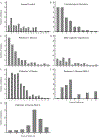TMEM106B Effect on cognition in Parkinson disease and frontotemporal dementia
- PMID: 30973966
- PMCID: PMC6953172
- DOI: 10.1002/ana.25486
TMEM106B Effect on cognition in Parkinson disease and frontotemporal dementia
Abstract
Objective: Common variants near TMEM106B associate with risk of developing frontotemporal dementia (FTD). Emerging evidence suggests a role for TMEM106B in neurodegenerative processes beyond FTD. We evaluate the effect of TMEM106B genotype on cognitive decline across multiple neurogenerative diseases.
Methods: We longitudinally followed 870 subjects with diagnoses of Parkinson disease (PD; n = 179), FTD (n = 179), Alzheimer disease (AD; n = 300), memory-predominant mild cognitive impairment (MCI; n = 75), or neurologically normal control subjects (NC; n = 137) at the University of Pennsylvania (UPenn). All participants had annual Mini-Mental State Examination (MMSE; median follow-up duration = 3.0 years) and were genotyped at TMEM106B index single nucleotide polymorphism rs1990622. Genotype effects on cognition were confirmed by extending analyses to additional cognitive instruments (Mattis Dementia Rating Scale-2 [DRS-2] and Montreal Cognitive Assessment [MoCA]) and to an international validation cohort (Parkinson's Progression Markers Initiative [PPMI], N = 371).
Results: The TMEM106B rs1990622T allele, linked to increased risk of FTD, associated with greater MMSE decline over time in PD subjects but not in AD or MCI subjects. For FTD subjects, rs1990622T associated with more rapid decrease in MMSE only under the minor-allele, rs1990622C , dominant model. Among PD patients, rs1990622T carriers from the UPenn cohort demonstrated more rapid longitudinal decline in DRS-2 scores. Finally, in the PPMI cohort, TMEM106B risk allele carriers demonstrated more rapid longitudinal decline in MoCA scores.
Interpretation: Irrespective of cognitive instrument or cohort assessed, TMEM106B acts as a genetic modifier for cognitive trajectory in PD. Our results implicate lysosomal dysfunction in the pathogenesis of cognitive decline in 2 different proteinopathies. ANN NEUROL 2019;85:801-811.
© 2019 American Neurological Association.
Conflict of interest statement
Figures





Comment in
-
Frontotemporal dementia risk variant accelerates cognitive decline in Parkinson disease.Nat Rev Neurol. 2019 Jun;15(6):307. doi: 10.1038/s41582-019-0196-y. Nat Rev Neurol. 2019. PMID: 31036955 No abstract available.
References
-
- Arnold SE, Toledo JB, Appleby DH, et al. Comparative survey of the topographical distribution of signature molecular lesions in major neurodegenerative diseases. [Internet]. J. Comp. Neurol 2013;521(18):4339–55.[cited 2018 Sep 29] Available from: http://doi.wiley.com/10.1002/cne.23430 - DOI - PMC - PubMed
-
- Robinson JL, Lee EB, Xie SX, et al. Neurodegenerative disease concomitant proteinopathies are prevalent, age-related and APOE4-associated [Internet]. Brain 2018;141(7):2181–2193.[cited 2018 Sep 29] Available from: https://academic.oup.com/brain/article/141/7/2181/5033683 - PMC - PubMed
-
- Van Deerlin VM, Sleiman PMA, Martinez-Lage M, et al. Common variants at 7p21 are associated with frontotemporal lobar degeneration with TDP-43 inclusions [Internet]. Nat. Genet 2010;42(3):234–239.[cited 2018 Sep 28] Available from: http://www.nature.com/articles/ng.536 - PMC - PubMed
-
- Gallagher MD, Posavi M, Huang P, et al. A Dementia-Associated Risk Variant near TMEM106B Alters Chromatin Architecture and Gene Expression. [Internet]. Am. J. Hum. Genet 2017;101(5):643–663.[cited 2018 Oct 9] Available from: https://linkinghub.elsevier.com/retrieve/pii/S0002929717303713 - PMC - PubMed
-
- Chen-Plotkin AS, Unger TL, Gallagher MD, et al. TMEM106B, the Risk Gene for Frontotemporal Dementia, Is Regulated by the microRNA-132/212 Cluster and Affects Progranulin Pathways [Internet]. J. Neurosci 2012;32(33):11213–11227.Available from: http://www.jneurosci.org/cgi/doi/10.1523/JNEUROSCI.0521-12.2012 - DOI - PMC - PubMed
Publication types
MeSH terms
Substances
Grants and funding
LinkOut - more resources
Full Text Sources
Medical

